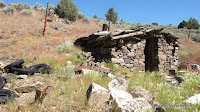 We learned by talking to park rangers that the town is pretty much a company town, owned by the Marshall family, and the buildings are mostly all posted "private-no trespassing." Though most stand in pretty good shape, they aren't necessarily "lovingly cared for".
We learned by talking to park rangers that the town is pretty much a company town, owned by the Marshall family, and the buildings are mostly all posted "private-no trespassing." Though most stand in pretty good shape, they aren't necessarily "lovingly cared for".Ione was at one time the county seat, but later lost that privilege to the town of Belmont. Ione was a silver mining town, and by 1864 she boasted a population of over 600, but the classic boom to bust story is told again - by 1868 the population had diminished to less than 1800. The later discovery of mercury breathed new life into the town, but it was a last, short gasp.
 Now, there are ruins and abandoned buildings to photograph, if you can work around all the "no trespassing" signs. Ghosttowns.com has a great description of Ione, but it's not up to date. There are no services at all available now. The gas pumps in front of the saloon are gone, the mercantile is closed, and the sweet little park where children might play is overgrown with fox tails. There are no public restrooms either, so be prepared! The last of the businesses closed in 2006 according to the rangers, who used to frequent the dining establishment there. Now, there's only one family left, and the school bus from Gabbs comes all the way out to pick up their two children.
Now, there are ruins and abandoned buildings to photograph, if you can work around all the "no trespassing" signs. Ghosttowns.com has a great description of Ione, but it's not up to date. There are no services at all available now. The gas pumps in front of the saloon are gone, the mercantile is closed, and the sweet little park where children might play is overgrown with fox tails. There are no public restrooms either, so be prepared! The last of the businesses closed in 2006 according to the rangers, who used to frequent the dining establishment there. Now, there's only one family left, and the school bus from Gabbs comes all the way out to pick up their two children.There's a fork in the road, to the south, on the way out of town, which leads to the cemetery. We explored the graves, noting the wide range of dates, and then had lunch on the tailgate. A good place to admire the valley and think about what life there was like when all the mines and little towns were humming with activity.
Plotting our return to camp we saw Grantsville on the map and decided to check it out. What a find! Like Ione, there are a lot of old buildings, both wood and stone, still standing (in varying degrees of decrepitude) but there are no "keep out" or "no trespassing" signs.
We could see evidence of many stone foundations for the typical miner's tent-house, wooden buildings, brick buildings, and best of all a gushing spring so the availability of water apparently wasn't any problem at all. Though the town had a sort life span, it must have been nice while it lasted. Now, wildlife must really appreciate this nice little pool. There's more information on the town's history at Ghosttown.com
Returning back to the campground we spied what looked like a couple of wooden buildings tucked up in the trees. Following the road up past several rusted out automobiles we discovered an abandoned homestead. We learned later the place is known as Ames Camp (this is about halfway between Berlin and Grantsville.) It must have been quite a place when it was occupied. It looks to have been abandoned for at least 40 or 50 years as the vintage of the youngest old rusty vehicle on the property is circa 1949.
The basement room of the main house cut in to the rock, is cool in hot weather. It has kitchen cabinets and a small oil stove, so could have been a summer kitchen or a separate living quarters. Upstairs is a kitchen and two other rooms. There are several outbuildings, possibly a garage/workshop, chicken coop, and machine shop, at least that's our interpretation based on what's been left behind. We found the suggestion of two wells, so the place was probably pretty comfortable for the residents. Now the buildings provide homes for a multitude of packrats and other natives, none of which came out to visit which was fine with us!
We had great fun in all three locations, admiring the workmanship of buildings that have withstood the elements for so many years, guessing at what the purpose of certain tools, machines or buildings might have been, and imagining what life must have been like when these towns were bustling with activity.
It was a long day bouncing over dirt roads however, so we were happy to see camp again, and the modern comforts of our little RV home!
There are a few more photos here
















































